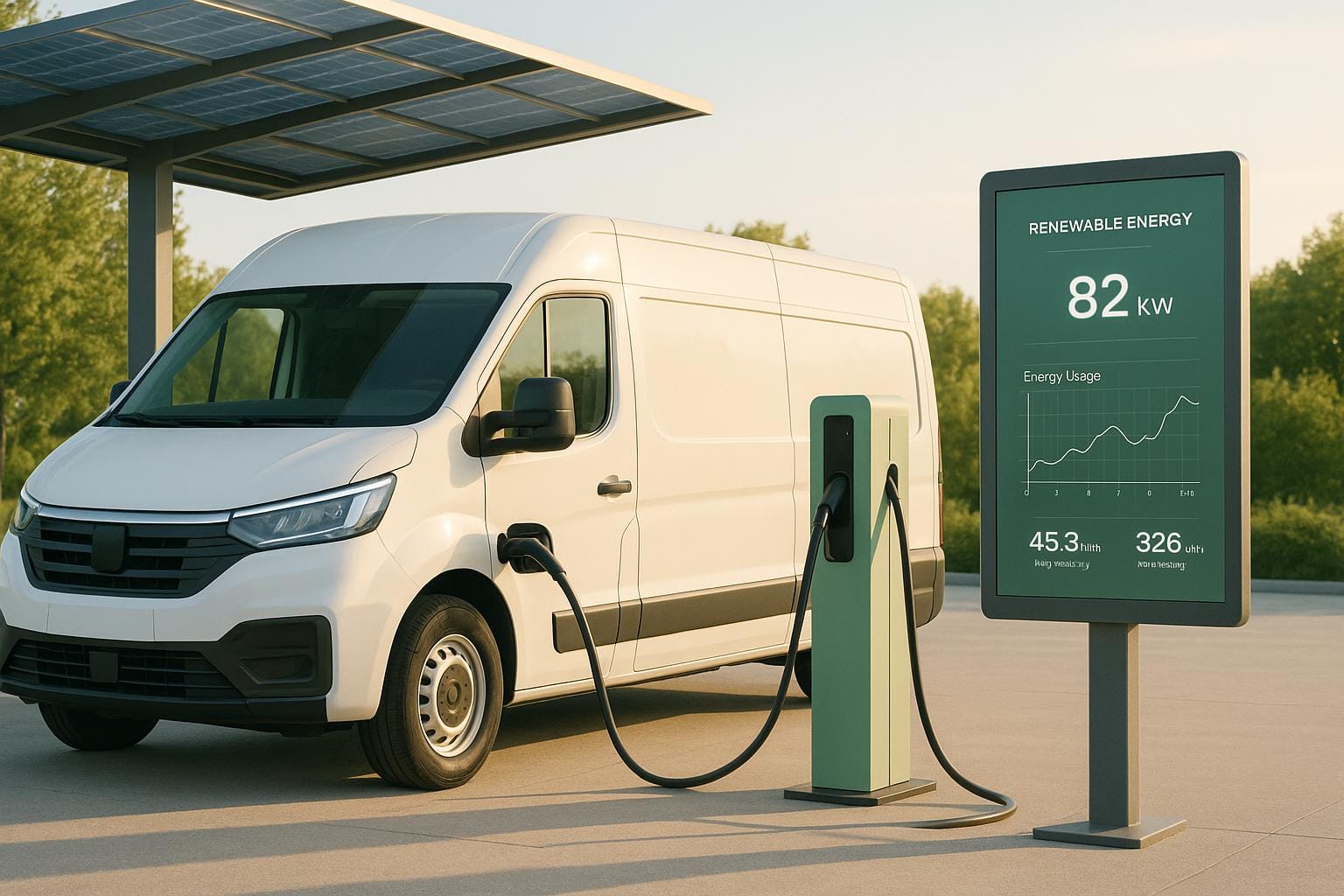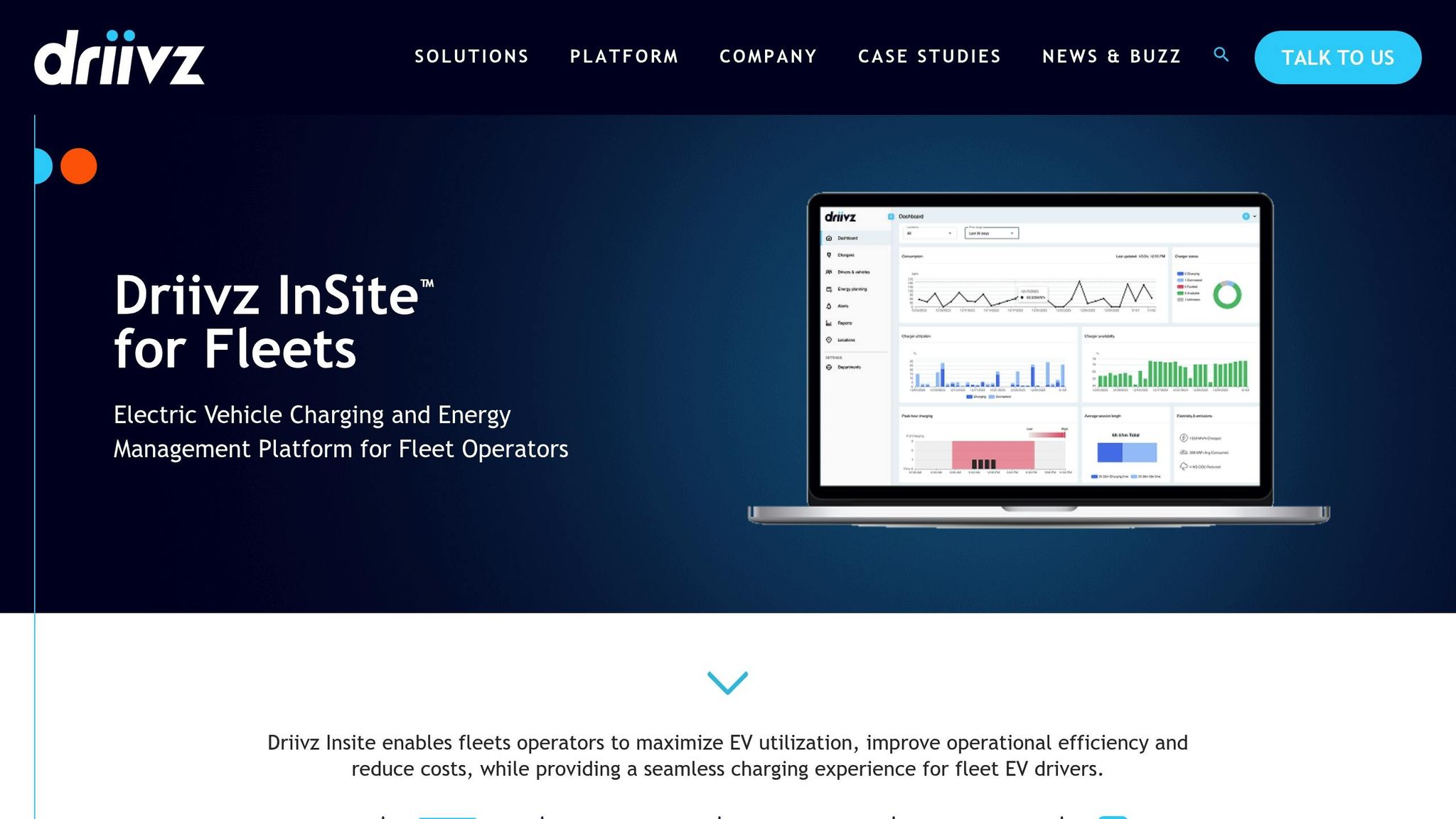Ultimate Guide to Renewable Energy Monitoring for Fleets
Explore how renewable energy monitoring systems enhance fleet efficiency, reduce costs, and ensure compliance with UK regulations.

Renewable energy monitoring is transforming how UK fleets operate, helping businesses save money, meet regulations, and reduce emissions. With the government phasing out petrol and diesel vehicle sales and aiming for net zero by 2050, fleet managers need tools to track energy use, optimise charging, and improve efficiency.
Here’s what you need to know:
- What It Is: Tracks energy consumption for electric vehicles (EVs), charging stations, and renewable energy sources like solar panels.
- Why It Matters: Helps fleets cut costs by charging during off-peak hours, avoid emissions-related charges, and secure lower insurance premiums.
- Key Features: Real-time telematics, charging infrastructure monitoring, and analytics dashboards for compliance and performance tracking.
- Set-Up Steps: Audit your fleet, install telematics and energy management systems, train your team, and establish workflows.
- Compliance: Align with UK frameworks like SECR to track and report energy use and emissions accurately.
Renewable energy monitoring isn’t just about meeting regulations - it’s a smart way to save money and future-proof your fleet.
Driivz InSite: EV Charging and Energy Management for Fleets

Key Parts of Renewable Energy Monitoring Systems
Transitioning to cleaner fleet operations requires tools that offer comprehensive insights into energy usage, charging, and performance. Renewable energy monitoring systems combine critical technologies that empower fleet managers to make smarter decisions as they adopt cleaner solutions.
Telematics Platforms for Real-Time Data Collection
Telematics platforms form the core of renewable energy monitoring, capturing data on vehicle performance, driver habits, and energy consumption. Using GPS and advanced analytics, these systems monitor key metrics like location, acceleration, braking, speeding, and idling in real time.
For electric and hybrid vehicles, telematics goes a step further by tracking battery health, charging patterns, and energy efficiency under various driving conditions. This information is vital for route planning and predictive maintenance, allowing managers to address potential problems before they escalate into costly repairs.
One example is GRS Fleet Telematics, which offers dual-tracker solutions. These not only enhance security but also gather detailed data on vehicle performance and energy usage trends.
The real-time feedback from telematics enables fleet managers to act quickly on inefficiencies. For instance, if a driver frequently accelerates aggressively, draining the battery faster, targeted coaching can help improve their driving style. Studies suggest that optimising driving behaviour can reduce CO2 emissions by 15% while cutting operating expenses by 10%.
Modern telematics systems also focus on driver performance analytics, identifying habits like harsh braking, excessive idling, or poor route choices that impact energy consumption. These insights are crucial for monitoring and improving charging infrastructure efficiency.
Charging Infrastructure Monitoring
Efficient charging infrastructure management is a cornerstone for fleets using electric vehicles. Smart, cloud-based systems track charging sessions, monitor energy sources, and provide live updates on charging station availability.
These systems gather data on energy sourcing and load management, ensuring charging aligns with grid capacity and fluctuating energy tariffs. This becomes especially relevant when renewable energy sources, like solar panels or wind turbines, are integrated at depots.
Reliable monitoring systems ensure consistent charging operations with minimal downtime, which is essential for maintaining fleet productivity during electrification.
Another key feature is dynamic load balancing, which prevents electrical overloads when multiple vehicles charge simultaneously. This capability is crucial as fleet electrification expands, helping avoid costly grid upgrades that could delay broader adoption.
By analysing energy usage patterns, fleet managers can schedule charging during off-peak hours when electricity rates are lower. This approach can lead to considerable cost reductions, particularly for larger fleets. These insights are then fed into analytics dashboards, turning raw data into actionable strategies.
Analytics and Reporting Dashboards
Analytics and reporting dashboards play a pivotal role in turning telematics and charging data into meaningful insights. These platforms track sustainability metrics, carbon footprint reductions, and compliance with UK regulations like the Streamlined Energy and Carbon Reporting (SECR) framework.
With fleet emissions contributing to 10% of the UK's total carbon output, accurate reporting is essential for meeting both regulatory standards and corporate sustainability targets. Dashboards offer tools to showcase environmental impact and progress toward goals.
Modern analytics platforms also include predictive features, such as forecasting maintenance needs, optimising charging schedules based on tariff changes, and tracking carbon emission reductions over time. These capabilities support the UK government's target of achieving 0g CO2/km fleet emissions by 2035 for cars and vans.
Beyond compliance, these tools highlight opportunities for improving operational efficiency and cutting costs. Fleet managers can identify underused vehicles, streamline routes, and make data-backed decisions on vehicle replacements using performance insights.
How to Set Up Renewable Energy Monitoring for Fleets
Setting up renewable energy monitoring for fleets involves three main steps: evaluating fleet needs and sustainability goals, installing the necessary hardware and software, and establishing effective training and workflows. These steps not only help reduce costs but also support compliance with regulations and improve efficiency.
Evaluate Fleet Needs and Sustainability Goals
The first step is to align your fleet's operations with your sustainability objectives. Start by auditing your current fleet. This includes analysing energy usage, vehicle types, fuel consumption, annual mileage, and operational routes. For fleets transitioning to electric vehicles (EVs), identify which vehicles are suitable for electrification based on their range requirements and charging infrastructure availability.
Set clear sustainability targets that meet UK regulatory standards and align with your organisation's goals. These could include quarterly milestones for reducing carbon emissions, cutting energy costs, or improving charging efficiency.
Examine your existing charging infrastructure, considering depot locations, electrical capacity, and peak operational times. If feasible, explore integrating renewable energy sources, like solar panels, at charging locations to reduce reliance on the grid and lower costs.
In summary, audit your fleet, set measurable sustainability goals, and budget for the necessary upgrades to support your renewable energy strategy.
Install Telematics Hardware and Software
Next, equip your fleet with the right hardware and software. This includes telematics devices, EV chargers, and energy management systems. UK fleet managers can consider solutions from providers like GRS Fleet Telematics for integrated telematics capabilities.
Telematics devices are installed in vehicles to monitor key metrics such as battery levels, energy consumption, charging history, and operational data. For fleets using solar-powered solutions, solar-powered asset tracking devices can further enhance monitoring while reducing grid dependency.
EV chargers should include features to track station availability, usage patterns, and energy flow. Smart charging systems, integrated with energy management software, can optimise charging schedules based on electricity tariffs and grid capacity.
On the software side, EV telematics platforms collect real-time data, providing automated alerts for low battery levels, maintenance needs, and unusual driving behaviours. Energy Management Software (EMS) acts as the control centre, balancing energy consumption with supply and optimising charging cycles. Some advanced EMS platforms even offer Virtual Power Plant functionalities, which can generate additional revenue.
To ensure seamless operation, integrate these systems with your existing fleet management tools using APIs and open interfaces. This allows monitoring data to flow directly into your current workflows without causing disruptions.
Training and Workflow Setup
The final step is to train your team and establish standard workflows to make the most of your monitoring systems.
Provide targeted training for both managers and drivers. Fleet managers should learn how to navigate dashboards, interpret data, and manage alerts. This enables them to analyse energy consumption, identify inefficient routes or behaviours, and address maintenance alerts proactively.
For drivers, focus on energy-efficient driving techniques and proper charging practices. Educating drivers on how their actions impact the data collected can encourage better habits and improve overall efficiency.
Standardise procedures for handling system alerts, scheduling maintenance, and managing charging cycles during peak and off-peak hours. Hold regular review sessions to examine fleet performance metrics, monitor carbon footprint reductions, and track progress toward your sustainability goals.
Finally, establish reporting protocols that comply with UK requirements, such as the Streamlined Energy and Carbon Reporting (SECR) framework. This ensures regulatory compliance while providing a clear picture of your progress toward sustainability targets.
Best Practices for Renewable Energy Reporting and Compliance in the UK
Navigating renewable energy reporting in the UK requires a solid grasp of local frameworks, data-driven strategies for improving operations, and a strong focus on protecting sensitive information. When done right, compliance can lead to both operational efficiencies and sustainability gains.
Meeting UK Sustainability Reporting Standards
Businesses in the UK are required to report their energy usage and carbon emissions in line with established guidelines. For instance, the Streamlined Energy and Carbon Reporting (SECR) framework mandates organisations to disclose details like electricity, gas, and transport fuel consumption. Fleet operators, in particular, should monitor both direct emissions (Scope 1) and indirect emissions from purchased electricity (Scope 2).
Larger organisations may also need to align with the Task Force on Climate-related Financial Disclosures (TCFD), which focuses on transparency around climate-related risks and opportunities. For those operating across Europe, the Corporate Sustainability Reporting Directive (CSRD) might also come into play.
These frameworks don’t just stop at reporting; they emphasise measurable improvements. For example, companies can track energy efficiency gains through initiatives like route optimisation, driver training programmes, or adopting renewable energy sources. These metrics not only meet compliance requirements but also sharpen operational strategies.
Using Data for Better Operations
Compliance is just the starting point - data analytics can take fleet management to the next level. By analysing energy consumption trends, businesses can identify peak demand periods, optimise charging schedules, and even reduce electricity costs while supporting grid stability.
Real-time data from telematics platforms, such as those offered by GRS Fleet Telematics (https://grsft.com), provides actionable insights. These tools help fleet managers allocate costs more effectively, track carbon footprints, and maximise charging infrastructure efficiency. Additionally, predictive analytics can flag maintenance needs early, minimising the risk of unexpected disruptions.
Data Privacy and Security
Telematics systems handle vast amounts of sensitive data, making compliance with UK GDPR regulations non-negotiable. Fleet managers should collect only the data necessary for business purposes, following the principle of data minimisation. Stringent access controls - based on roles - and encryption for both data in transit and at rest are crucial for protecting this information.
Clear policies on data retention are equally important. Personal data should only be kept for as long as GDPR permits. When working with third-party vendors, ensure robust data processing agreements are in place to mitigate risks.
To further strengthen security, establish thorough incident response plans, including timely breach notifications as required by the Information Commissioner’s Office. Regular staff training on data protection practices is also key to maintaining a secure environment. When combined with telematics systems, these measures not only ensure compliance but also contribute to a more sustainable and efficient fleet management approach.
Next Steps in Renewable Energy Monitoring
Renewable energy monitoring is becoming a cornerstone for sustainability and operational efficiency in UK fleets. By balancing regulatory compliance, cost reduction, and environmental responsibility, this technology is a must-have for businesses looking to stay ahead.
The journey starts with evaluating your fleet's current energy usage. Identify which vehicles have the highest fuel consumption, assess your charging infrastructure needs, and establish baseline data for energy use and carbon emissions. These initial steps provide the groundwork for setting realistic goals and tracking progress effectively. Once this energy profile is clear, you can roll out solutions in manageable phases.
Start small with a pilot programme to test the systems and refine your approach before full-scale implementation. This step-by-step method reduces risks and gives your team time to become familiar with the tools and reporting processes.
Incorporate modern telematics to gain real-time insights into energy usage. Equip your drivers and managers with the training they need to interpret and act on the monitoring data, driving continuous improvements in efficiency.
The financial advantages go beyond just saving on fuel. For instance, renewable energy monitoring can help you optimise charging schedules to take advantage of off-peak electricity rates, cutting overall energy costs. Plus, the detailed reporting features can support applications for government grants and sustainability incentives available to UK businesses.
Preparing for compliance is another key step. Even if your organisation isn’t currently required to meet specific reporting standards, having a robust monitoring system in place ensures you’re ready for future regulations. Once compliance is achieved, consider working with industry experts to enhance your system further.
To build on your monitoring foundation, partner with trusted providers like GRS Fleet Telematics. Their solutions not only support renewable energy tracking but also offer added security, including a 91% recovery rate for stolen vehicles. With monthly rates starting at just £7.99, their services are both effective and affordable.
Transitioning to renewable energy monitoring is about more than meeting today’s demands - it’s about staying ready for tomorrow. As the UK advances towards its net-zero goals, businesses with established systems will be better equipped to adapt to new regulations, secure funding opportunities, and showcase their commitment to sustainability.
Kick things off with an energy audit, choose the right monitoring solutions, and map out a clear implementation plan. The sooner you act, the sooner you’ll start enjoying the operational and financial rewards that renewable energy monitoring brings.
FAQs
How do renewable energy monitoring systems help fleet managers save on operational costs?
Renewable energy monitoring systems allow fleet managers to keep a close eye on energy usage in real time. This makes it easier to use renewable energy sources efficiently. By fine-tuning energy consumption and planning vehicle charging at the right times, these systems can help cut down on both fuel and electricity expenses.
On top of that, they contribute to reducing vehicle downtime and lowering maintenance costs through smarter energy management. Over time, this approach improves how smoothly operations run, trims overall costs, and supports environmentally friendly practices for your fleet.
How can fleet managers in the UK ensure they meet sustainability reporting requirements when using renewable energy monitoring tools?
To meet the UK's sustainability reporting standards, fleet managers need to prioritise collecting precise and clear data on fleet emissions, including emissions from grey fleets. This information should be in line with the UK's Sustainability Disclosure Requirements (SDR) and other applicable frameworks, such as the Energy Savings Opportunity Scheme (ESOS).
Staying up to date with changes in government guidelines and ensuring that reporting processes adhere to legal requirements is crucial for compliance. Using tools to track renewable energy usage can simplify data collection and contribute to achieving sustainability objectives efficiently.
What are the main advantages of using telematics for monitoring renewable energy in fleets?
Telematics systems give fleet managers access to real-time data, enabling them to streamline operations and boost energy efficiency. By tracking routes, minimising unnecessary mileage, and promoting safer driving habits, these tools help reduce fuel consumption and lower emissions - key steps towards running a more eco-friendly fleet.
On top of that, telematics provides detailed insights into vehicle performance, such as idling times and maintenance requirements. This not only aids in smarter energy use but also helps cut operational expenses, making fleet management both cost-effective and environmentally conscious across the UK.
